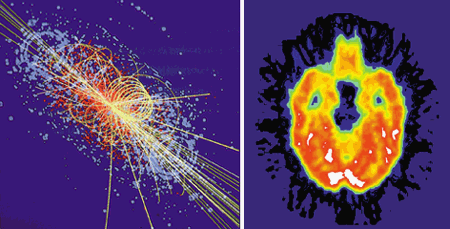Technology transfer is alive and kicking in the high-energy physics community and has led to a wealth of applications in industry and medicine, as Valerie Jamieson discovers.

So you think high-energy physics is an esoteric branch of science with little relevance to everyday life? Then you’re wrong. High-energy physics is, in fact, a hot bed of innovation. The tools that particle physicists have developed to recreate and probe the building blocks of matter have led to a wealth of applications in industry and medicine. That said, many of these spin-offs do not betray their origins in basic science. But that hasn’t stopped them from benefiting society.
The most famous and far-reaching example is undoubtedly the World Wide Web, invented at the CERN laboratory in Geneva by Tim Berners-Lee to help particle physicists handle and share experimental data. Particle physicists revel in its success. And rightly so – the Web has transformed the Internet from an academic tool into a telecommunications revolution. The Forrester Research organization predicts that the amount of “e-business” conducted over the Web will soar from $657bn in 2000 to $6800bn by 2004. And if that isn’t enough, the Internet is fuelling the boom in the optoelectronics industry – currently estimated to be worth $140bn and growing by 25% each year. And how much money does CERN make from this runaway success story? None.
Chris Jones, head of the technology-transfer service at CERN, explains that Berners-Lee took the deliberate decision to make his invention available free of charge to everyone. “The Web would never have happened if the lab had tried to exploit it,” he insists.
This “hands off” approach seems to encourage innovation in high-energy physics labs and in university departments (see box). A small number of companies have recently been spun off from CERN, but Jones attributes them to serendipity rather than a deliberate move by the lab. “Spin-offs have just happened when researchers with a good idea have met the right people,” he says. The main aim of technology transfer at CERN, says Jones, is to show that particle physics is relevant to the outside world, rather than to fund basic research.
One recent spin-off is Single Source, a Finnish company that sells software that was originally devised to manage documents and technical drawings for the Large Hadron Collider. The company was founded in 1997 by Ari-Pekka Hameri of the Helsinki Institute of Physics and seven co-workers from CERN. It now has more than 20 employees and over 20,000 people using its software. Hameri describes the company formation as a “Darwinian evolution” from the lab.
Much of the technology developed at CERN is too far from a commercial product for it be transferred directly to industry, explains Jones. That said, technology transfer happens naturally as companies and experimentalists work together to improve technology. Tony Wright is marketing director of Electron Tubes, a UK company that recently sold thousands of photomultipliers to the BaBar experiment at the Stanford Linear Accelerator Center in California and the Borexino solar-neutrino detector at the Gran Sasso laboratory in Italy. Wright has first-hand experience of particle physicists. “They make impossible demands,” he says. “Current technology is not good enough for many particle-physics experiments.”
Electron Tubes had to supply the Borexino experiment with glass photomultiplier tubes that were essentially free from radioactive impurities. Such contaminants can easily swamp the tiny telltale signals produced by solar neutrinos. The difficulty is that natural potassium is a key ingredient in glass making, yet it contains a small amount of radioactive potassium-40. The company’s answer was to develop a new industrial glass-making process minus the potassium. “We certainly exploit some of these wacky ideas from particle physics,” adds Wright, pointing to the company’s range of radiopure light detectors for medical applications and radiation monitoring.
Theorists get in on the act
Particle theorist Christine Davies and her group at Glasgow University in the UK have recently teamed up with the aerospace and defence company BAe Systems to apply techniques from quantum-chromodynamics calculations to the design of ships.
The large number of radar antennae on modern ships causes a real problem for designers, who must minimize signal interference and reduce the risk to sailors from electromagnetic radiation. Currently engineers use a rule of thumb to find the best positions for the antennae. But BAe Systems recognized that a more scientific approach was needed to optimize radar coverage as the complexity of the resulting electromagnetic-field pattern increases.
Davies and her co-workers are experts in calculating the properties of particles and their interactions by splitting space-time into a lattice of points. Their calculations, which require huge amounts of computing power, involve inverting large matrices in record time. The Glasgow team is now applying exactly the same matrix-inversion technique to unravel the electromagnetic field on ships. The results are expected to show naval engineers where best to place the radar antennae.
Medical benefits
Medicine is one of the major beneficiaries of particle physics. Recent advances in accelerator technology, for example, now mean that hospitals can buy their own cyclotrons to manufacture radioisotopes for positron-emission-tomography scans, and other nuclear medicine, on an industrial scale. Ion Beam Applications – a spin-off from the Catholic University of Louvain in Belgium – currently supplies accelerators that are a few metres in diameter and can be operated without the intervention of specialist accelerator physicists. However, over 70% of the firm’s revenue comes from the sale of electron-beam accelerators that are used to sterilize medical instruments, pasteurize food and treat plastics. The company, which was founded in 1986, now has over 1100 employees worldwide and its sales in the first half of 2000 topped Euro 110m ($100m).
Meanwhile, positron emission tomography (PET) – which has its roots in particle physics – has saved countless lives and dispensed with the need for exploratory surgery in many cases. PET scanners work by detecting the gamma rays that are produced when a positron emitted by a radioisotope annihilates an electron.
Although PET scanners have been available for 30 years, the cost of conventional machines is prohibitive for many hospitals due to the expensive array of detectors and amplifiers that are needed to convert the gamma rays into an electronic signal. However, particle physicists are working in conjunction with both clinicians and industrial researchers to develop larger and cheaper gamma-ray detectors. Last year, for example, Bob Ott at the Institute of Cancer Research together with colleagues at the Rutherford Appleton Laboratory and the Royal Marsden Hospital, all in the UK, developed an affordable large-scale gamma-ray detector. The device is based on the barium-fluoride crystals and wire chambers that are found in particle-physics experiments.
And last year Time magazine’s invention of the year was a new medical scanner that simultaneously combines images of the metabolic processes inside the body from PET with the detailed anatomical images from computerized-tomography scanners. The device was designed and built by former particle physicist David Townsend and his colleague Ronald Nutt, both now at the University of Pittsburgh Medical Center in the US. The combination scanner allows doctors to determine the location of a tumour much more precisely. Previously, doctors had to match up PET and CT scans by eye. In the US, increasing numbers of patients are routinely having PET scans. At over $2000 per scan, PET promises to be a big business in itself.
Spin-offs from future colliders
But the innovation doesn’t stop there. A huge amount of effort is being invested in the design of detectors that will measure up to the rigorous demands of CERN’s Large Hadron Collider (LHC). Due to come on line in 2005, the LHC will collide bunches of protons with energies of 7 TeV (7 × 1012 eV) every 25 ns. The detectors closest to the collision point have to withstand a harsh radiation environment, be capable of detecting a particle with pinpoint accuracy and spit out their data fast – very fast. The research and development that has been carried out on materials and electronics could lead to numerous spin-offs, ranging from low-dose digital dental-radiology detectors to new chip-packaging materials that can conduct away heat efficiently.
As soon as the experiments at the LHC begin recording collisions, data will pour out at a rate that is equivalent to a 1 km pile of CD ROMs every second. Particle physicists are currently building fast electronics that can filter information from the most interesting collisions, reducing the data by a factor of 109 in less than a microsecond. But that still leaves a lot of data to be analysed by thousands of physicists around the world. For this reason, particle physicists are developing the Grid – a way of harnessing the combined might of computers around the world to analyse the data. Indeed, they have already teamed up with computer companies – such as Compaq, IBM, Silicon Graphics and Sun – to speed up the infrastructure of the network. Moreover, they are developing software that will allow researchers to manipulate data at high speed across the network. The Grid is also expected to benefit astronomers and genome scientists, who also have to deal with vast quantities of data.
So, do you still think that high-energy physics is an esoteric branch of science with little relevance to everyday life? Thought not.



